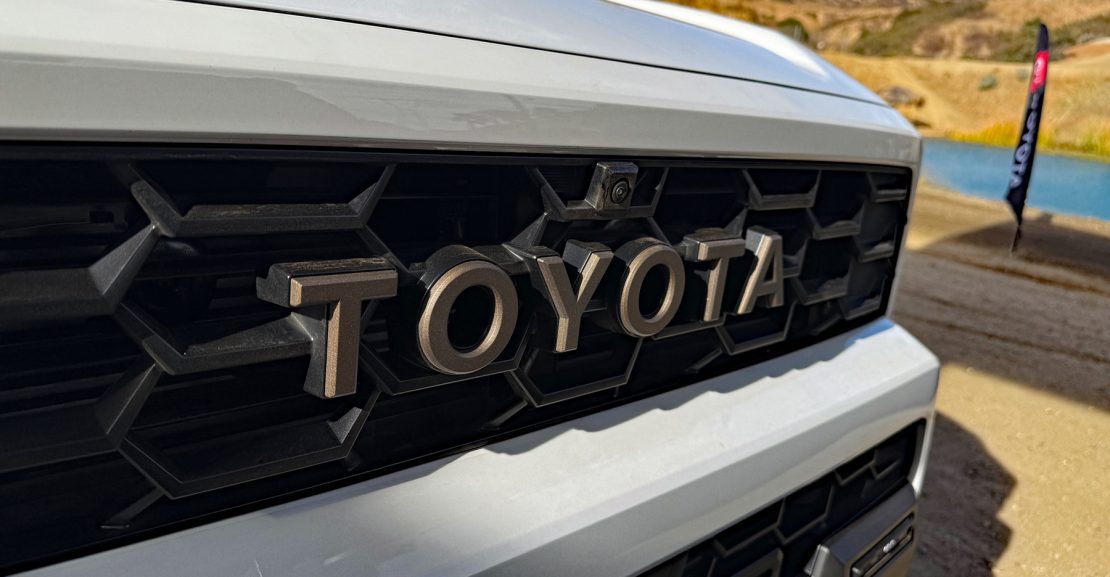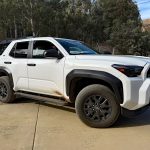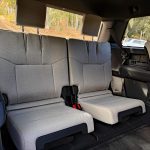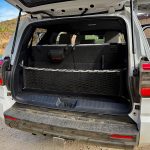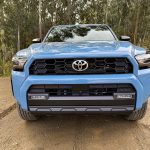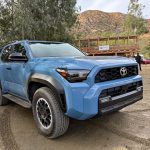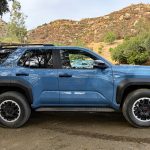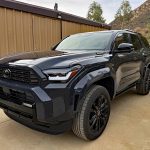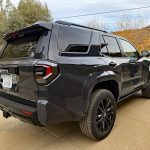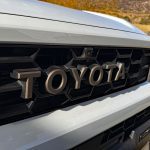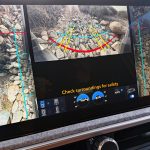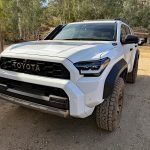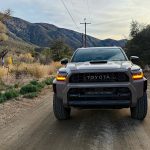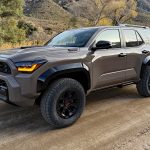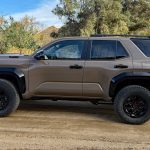
It’s been 15 years since we last saw a completely new Toyota 4Runner. When most vehicle lifecycles last about 8 years, 2010 was forever ago. So, to say the SUV was due for an update is an understatement. What’s really interesting, however, is that the 2025 Toyota 4Runner stays true to its rugged roots while amping up the tech and overall drivability. In short, Toyota did a darn fine job with this sixth-generation SUV.
2025 Toyota 4Runner: First Spin
The 4Runner has its roots steeped in weekend off-road adventures. A cross between the Toyota Trekker and the Land Cruiser, the original 4Runner combined off-road capability with on-road comfort. While this SUV has been slow to make big changes, it has been the result of continuous improvement and upgrades throughout the years. Initially a two-seater, the 4Runner didn’t get a second row until its second generation. Over the years, it added more ground clearance, an independent front suspension, side-impact protection and anti-lock brakes. An automatic transmission replaced the manual in 2001. As a pre-runner to its fifth generation (pun intended), the 4Runner entered the Baja 1000 and finished second in its class.
Entering the current generation, the 4Runner married off-road prowess with modern technology, including wireless Apple CarPlay, a smooth hybrid powertrain and camera displays that wow.

i-Force vs i-Force Max
Let me start by saying both the gas and hybrid versions of the 2025 Toyota 4Runner are really well powered. The gas engine, called the i-Force, is a 2.4-liter turbocharged 4-cylinder that delivers 278 horsepower and 317 pound-feet of torque. This will be the base powertrain, found in the SR5, TRD Sport, TRD Sport Premium, TRD Off-Road, TRD Off-Road Premium and Limited trims. This is the same engine we see in the Tacoma, but while the Tacoma has a manual transmission option, the 4Runner is only equipped with an 8-speed automatic.
I thought this powertrain had plenty of get-up-and-go for swift acceleration as well as coming out of a stop light. While you hear the engine under hard acceleration, it didn’t sound or feel like it struggled. It felt like the right amount of power for a vehicle of this size.

The i-Force Max, the hybrid powertrain, felt better. With 326 combined horsepower and 465 pound-feet of torque, this powertrain borders on effortless. And, when off-roading, the low-end torque makes a huge difference during difficult climbs. I had the opportunty to test both powertrains off road, and the i-Force Max keeps on chugging steadily in steep inclines, whereas the i-Force requires a little more effort.
if you’re doing a lot of off-roading, the hybrid is definitely the powertrain you’ll want. But for everyday driving, the gas engine is the big winner–especially since it gets better highway fuel economy in most trims. Though not vetted by the EPA yet, Toyota estimates the 4Runner will get 25 to 26 mpg on the highway in every trim except the Limited. The i-Force Max, which is 4WD only, will get 24 mpg.
Driving impressions

Similar to the Tacoma, the 2025 Toyota 4Runner feels right sized. We tackled off-road and twisty on-road bits, and while I wouldn’t call the 4Runner sporty, I would say it borders on nimble. It had an excellent turning radius for miss-directed U-turns, and it stayed in its lane while “carving canyons.” In the off-road, it agilely handled tight maneuvers, steep inclines and rock crawls.
Though I only had a couple solid hours behind the wheel on road, it felt generally comfortable–from the seats to the driving position to the visibility out the windows. Off-road, it was just fun.
One of the design features that helps contribute to the 4Runner’s driving prowess: the hood lines. They bump up in such a way that mimic wheel placement, so you have a good idea of where your wheels are going to hit, without using a camera, just by looking over the hood.
Technological leaps
Whether the 2025 Toyota 4Runner is equipped with the standard 8-inch infotainment or the up-level 14-inch one, both systems have wireless Apple CarPlay and Android Auto as well as Toyota’s latest infotainment system. You’ll see USB-C charge ports instead of USB-A, and there is an available wireless phone charger.

All trim levels come standard with push-button start and passive entry, and with a Remote Connect subscription ($15 a month), you have the ability to use your phone as the key on uplevel models. There is also an available JBL-brand premium audio system on upper trims that includes a cool JBL Flex portable Bluetooth speaker that can be undocked and moved away from your vehicle.
Another great tech advance includes the camera views. If equipped with the Multi-Terrain Monitor (included on TRD Off-Road Premium, TRD Pro, and Trailhunter), you have selectable front, side and rear views that essentially provide a second set of eyes. In non-off-road trims (TRD Sport Premium, Limited and Platinum), you also have the Panoramic View Monitor standard, which gives 360-degree views as well as curb views. The base trims simply come with a back-up camera.
The 2025 4Runner is also well equipped in the safety-tech arena as well. Toyota has always done an amazing job at prioritizing safety and making it standard on all its vehicles. 4Runner is no different, and Toyota Safety Sense 3.0 is standard. This includes a pre-collision system with pedestrian detection, adaptive cruise control, lane-trace assist, automatic high beams and proactive driving assist, which uses cameras and radar to do things like slow the vehicle when driving into curves. Other standard safety features include front cross-traffic alert, traffic-jam assist, blind-spot monitoring and rear cross-traffic alert.
A few misses

While I generally think the new 4Runner is a home run, there are a few things that need some tweaks. Let’s start with the wireless charger. It starts to overheat your phone after about 30 minutes, and by the time 45 minutes rolls around, your phone stops charging due to excessive heat. If you’re only in your car for short bursts, this won’t be a problem, but if you take a lot of road trips or have a long commute, you’ll want to wire your phone in to charge.
Only gas models have an available third row in the 2025 Toyota 4Runner. While that in itself isn’t a miss, the third row itself is. If you are buying a vehicle because you actually need the third row regularly, this is not the vehicle for you. The seats themselves are flimsy and awkward, and anyone taller than about 5 feet will be eating their knees while sitting there. If, however, you intend to keep the third row folded flat and use them occasionally, this may work for you.
Finally, I want to talk about the vehicles with the front-facing or around-view cameras. They shut off at about 9 mph. I wish they were available at all speeds. I’ve recently tested trucks from General Motors that allow for keeping the side and front cameras on, and it’s hugely helpful when driving a large vehicle in small spaces. In Chicago, for example, I keep them on to ensure I’m staying out of the bike lanes. In an off-road situation, you may be traveling at 9 mph, go up to 12 mph and then drop down to 5 mph to tackle an obstacle, and it’s distracting to keep turning the cameras on when you need them.
Prices and Trim Levels

The 2025 Toyota 4Runner has nine, yes NINE, trim levels, with pricing ranging from about $41,000 to $67,000. So, here’s a quick overview of trims and pricing, including destination fees:
SR5 ($42,220):
Standard with the i-Force powertrain, includes 17-inch alloy wheels, 8-inch infotainment screen, available third-row seating, power rear window, fabric seats, blind spot monitoring, tow hitch receiver. RWD is standard, part-time 4WD is available.
TRD Sport ($48,700):
Adds color-keyed door handles, gloss-black hood scoop, heated power outside mirrors, 20-inch alloy wheels, 12.3-inch digital cluster, blind spot monitoring, tow hitch receiver. RWD is standard, part-time 4WD is available.
TRD Off-Road ($50,640):
Adds black door handles, skid plates, 18-inch alloy wheels, Multi-Terrain Select system, Crawl Control, electronically controlled locking rear differential. Part-time 4WD is standard. Available with i-Force Max powertrain.
TRD Sport Premium ($54,060):

Builds off the TRD Sport and adds leatherette seating surfaces, heated-and-ventilated front seats, heated steering wheel, 360-degree camera, hands-free power liftgate, 14-inch display.
TRD Off-Road Premium ($54,420):
Builds off the TRD Off-Road and adds leatherette seating surfaces, heated-and-ventilated front seats, heated steering wheel, hands-free power liftgate, 14-inch display, Multi-Terrain Monitor. Available with an i-Force Max powertrain.
Limited ($56,850):
Adds a moonroof, chrome roof rails, 20-inch alloy wheels, dual-zone climate controls, 360-degree camera, leather seats, front and rear park assist. RWD is standard, full-time 4WD is available. Available with i-Force Max powertrain.
Platinum ($64,310):
Standard with the i-Force Max hybrid powertrain and full-time 4WD, and it adds 20-inch gloss black alloy wheels, rain-sensing intermittent wipers, digital key capability, 360-camera, head-up display.
TRD Pro ($68,350):

Includes part-time 4WD, electronic locking rear differential, TRD black performance exhaust, Rigid Industries-brand LED fog lights, heritage-inspired Toyota grille, TRD Pro aluminum skid plate, 18-inch TRD alloy wheels, pre-wired DC power auxiliary switches, leatherette seats, Multi-Terrain Monitor.
Trailhunter ($68,350):
Builds on TRD Pro and adds Rigid Industries-brand white-and-amber color switching LED fog lights, frame-mounted steel rock rails, ARB-brand roof rack, high-strength underbody protection, 18-inch bronze-finish alloy wheels, LED liftgate light.
Our take
The 2025 Toyota 4Runner is one of those Janus-faced vehicles that has excellent off-road chops and on-road comfort. While we like the number of options and trims, it seems like overkill at times. For our money, we’d probably opt for the TRD Off-Road Premium for the heated-and-ventilated seats, larger infotainment screen and off-road prowess. While the i-Force Max powertrain is nice, we don’t put it on our must-have list, especially since it adds nearly $3k to the bottom line.

Listen to the Car Stuff Podcast
2025 Toyota 4Runner Pictures
Click below for enlarged images

